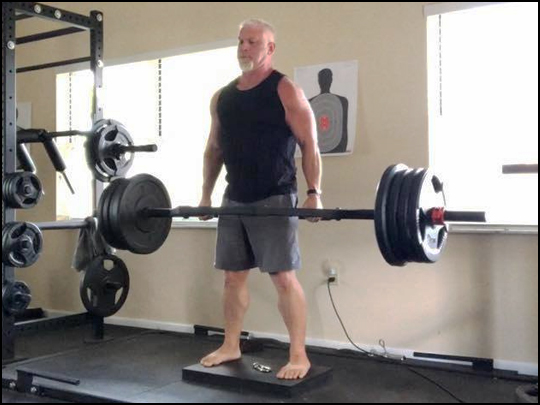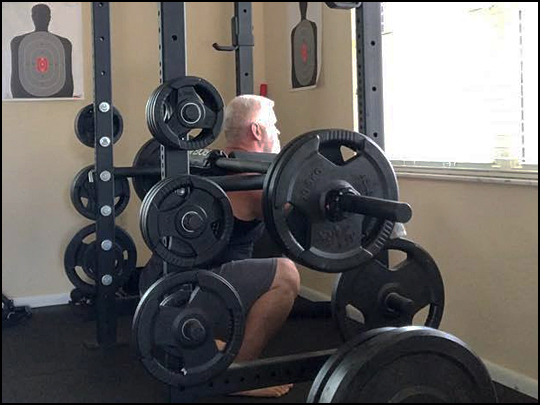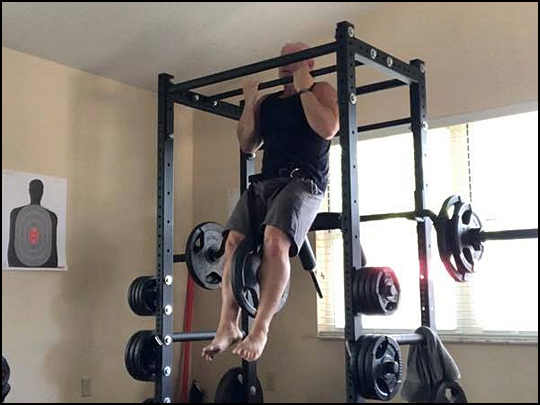In the September 1971 issue of Ironman magazine, in his article Is It Worth The Price?, Nautilus inventor Arthur Jones wrote,
“…every exercise should be carried to a point of utter failure, where no additional movement is momentarily possible. It is almost literally impossible for most people to work too hard—but it is easily possible for anybody to work too much.”
Fifty years later, despite an ever increasing body of evidence supporting Jones’ Nautilus training principles, you’ll still see most people in the gym doing far more exercises and sets than necessary while barely working hard. I am not exaggerating when I say the vast majority of trainees would get far better results if they spent less than half as much time in the gym but worked at least twice as hard.

Trap Bar Deadlift
What does it mean to work hard, though? Jones’ had an answer for that as well. To paraphrase, he once said if you perform a set of an exercise hard enough you should find it necessary to sit down afterwards. You should not just feel like sitting down, you should have to sit down to avoid falling down.
How do you train harder?
Use better, stricter exercise form
Proper exercise form keeps the targeted muscles working against relatively continuous, balanced resistance, without unloading or underloading and allowing them to rest, resulting in a faster rate of fatigue (inroad/time = intensity!). The stricter your form the harder an exercise is.
Don’t cheat, but don’t stop
Don’t cheat to get more reps as the exercise becomes harder. How well you perform each rep of an exercise is more important than how many reps you perform. Cheating might allow you to do more repetitions, but that is because it makes the exercise easier which is the opposite of what you want. Instead, continue to contract the target muscles as hard as possible without loosening your form.

Safety Bar Squat
Even if the weight stops moving you benefit from continuing to contract and fatigue the target muscles for a few more seconds (up to 10 if you are a beginner, but be more cautious and limit it to 5 if you have been training for six months or more). You my believe you have achieved momentary muscle failure, but if you continue to contract as hard as possible you might surprise yourself and find you are able to continue positive movement, even if just barely.
Let your muscles decide, not your mind
You don’t get to decide when the exercise is over, your muscles do. Regardless of how much your muscles burn, your heart pounds, or how winded you feel, continue to give your best effort until positive movement in strict form becomes impossible. Not unpleasant or uncomfortable; physically impossible. As long as you don’t feel any sharp pain or pain in your joints indicating injury, or become faint, dizzy, or nauseated (or if begin to lose your grip when pulling), continue to contract the target muscles against the resistance and move slowly and strictly until you could not do so even if someone put a gun to your head and threatened your life.
If you perform your exercises in this manner, and you use a level of resistance that allows you to achieve momentary muscle failure within around 60-90 seconds (although some will do better with a little shorter or longer time under load) you only need to perform one set of only one or two exercises per muscle group. Contrary to popular but misinformed opinion you do not need to perform a three or more sets of half a dozen or more exercises for each muscle group or work any muscle group more than twice weekly.

Weighted Chin Up
As an example, below are the two workouts I am currently alternating between which have been producing very good results. I perform the same eight exercises at the start of each, but alternate between different forearm and grip sequences at the end of the A workout and different abdominal and neck sequences at the end of the B workout.
I perform only one set to momentary muscle failure of each exercise, either dynamically using a weight that allows me to complete between two and four SuperSlow repetitions (10 seconds up, 10 seconds down, plus a few seconds for turnarounds and holds depending on the exercise), or statically using Timed Static Contraction (TSC) protocol. I rest only long enough between exercises to avoid becoming light-headed, winded, or nauseated, and am able to complete these workouts in under thirty minutes, for less than one hour of total weekly training time.
Workout A (Free Weights and Bodyweight)
- Safety Bar Squat
- Chin-Up
- Overhead Press
- Crunch
- Wrist Extension / TSC Pronation
- Wrist Curl / TSC Supination
- TSC Pinch Gripping / TSC Crush Gripping
Workout B (Free Weights and Bodyweight)
- Trap Bar Deadlift
- Dip
- Bent-Over Row
- Heel Raise
- TSC Dorsiflexion
- TSC Neck Flexion
- TSC Neck Extension
I’m doing all the above with free weights, bodyweight and statics, but here are the same workouts if I did them on machines. Of course, you can mix and match depending on the equipment available to you. Keep in mind any workout like this is only a starting point. Just because it works well for me does not mean it will work the same for you or anyone else. You must make adjustments based on your capabilities and how your body responds to exercise.
Workout A (Machines)
- Leg Press
- Underhand Grip Pulldown
- Overhead Press
- Abdominal Flexion
- Cable Wrist Extension / TSC Pronation
- Cable Wrist Curl / TSC Supination
- TSC Pinch Gripping / TSC Crush Gripping
Workout B (Machines)
- Trunk Extension (Hip and Back)
- Seated Dip or Chest Press
- Compound Mid Row
- Straight-Legged Calf Press
- TSC Dorsiflexion
- TSC Neck Flexion
- TSC Neck Extension
If you want to give these workouts a try and need help adapting them to your capabilities and available equipment and adjusting them based on your body’s response to exercise, I am available for consultations and online training and also explain this in numerous posts and videos in my private forum for HIT List members.

Comments on this entry are closed.
Hey Drew,
Thanks for the post. I am interested in your statement:
‘As an example, below are the two workouts I am currently alternating between which have been producing very good results.’
Considering that you have been working out for decades, and using the HIT protocols for much/all of this time, is it correct to state that you are getting ‘very good results’ as you started your current training after a layoff or reduced activity period?
I think I am right in saying that many HIT experts believe that with proper training you will reach your genetic potential (or very close to it) after a couple of years of using the most effective training protocols.
Just keen to know if you are still gaining strength/size after all your years of training, or whether you are getting back to your previous best.
Thanks again for sharing your knowledge.
Jim
Hey Jim, I’ve recently cut the workouts back (and have updated this article with the updated, briefer workouts) and am doing even better. I am discussing the reasons for the changes and my current progress in the Progress and Accountability section of the private forum for HIT List members.
“Let your muscles decide, not your mind” this is absolutely brilliant….
Drew,
I often begin a similar routine to the one described here with Chin-ups and Dips prior to Trap Bar Deadlifts because of how grip intense both chin-ups and deadlifts can be. Do you recommend Trap Bar Deadlifts as your starting exercise? I find Trap Bar Deadlifts one of the best overall strength exercise for the whole body but also tends to tax my grip strength by the time I reach the chin-ups.
My current Protocol for example:
1A) Chin-ups slow 10s-10s 4-6 reps
1B) Dips 10s-10s 4-6reps
1C) Trap Bar Deadlifts 8-12reps
As a general rule you should perform exercises in order from largest to smallest amount of muscle involved, so I recommend doing trap-bar deadlift first. It also helps to order exercises so you do not perform two that challenge your grip back-to-back. There are a few other reasons I recommend performing deadlifts before dips or chin-ups, which I cover in some of the videos on exercise selection and order in the private forum for HIT List members.
Hello Drew,
This was an excellent persuasive article on the importance of training harder. l But you also highlight the importance of exercising better strict form. I still find that intermediate trainees fall into the trap of “more is better” rather harder but shorter effort while maintaining strict form. you concisely express what is true but not necessarily popular. occasionally I will go that way myself. But I always find that it interferes with my goal of becoming leaner and stronger,
Do you have a hard copy book that I could purchase that includes perhaps 10 to 20 of your articles that you have shared for free especially where your knowledge and experience stands apart from the standard fitness industry? EG “…to improve muscular endurance you have to longer sets more often with easier weight…” , “to become a faster more powerful athlete you must lift fast…, etc. ? Is there any power, strength or body composition that comes from lifting weights faster?
I am planning to address these and more in the next edition of High Intensity Workouts and also cover all of these topics in videos in the private forum for HIT List members.
Thanks for the insightful and useful information Drew.
Is the Yates Row an exercise you have done regularly throughout your training? and if so how do you feel it matches up compared to the flat Barbell Row? I know Dorian Yates felt it put his lats in a mechanically stronger pulling position and hence he could use more weight compared to a flat row. However is the extra weight you can use more related to what appears to be a shorter range of motion involved in a Yates Row where you pull the bar to the navel area, compared to pulling it to the lower chest which seems more natural if you are in the flat position? In other words is there any evidence to suggest the Yates Row stimulates the lats more than the flat row?
Apologies for the wordy post and thanks again for the effort you put into your blog.
I have used it in my training, but it doesn’t work the lats more effectively than regular rows, it just changes the relative involvement of some of the other muscles in the shoulder girdle and involves the biceps more than the brachioradialis.
If you would like a detailed explanation of the underhand low row and regular barbell row I cover these in detail in a series of videos on how to properly perform dozens of free weight exercises in the private forum for HIT List members.
Drew,
Your suggestion to not attempt to increase resistance or repetitions or TUL at each workout ignores an important element: recovery. Mike Mentzer believed that if one were fully recovered from his previous workout, he should be able to improve performance if only by a single rep or a few pounds. Mike believed that recovery was the most under appreciated element of high intensity exercise.
It’s been my experience with myself and my personal training clients that a lack of appreciable strength increases is often a sign of overtraining. For those performing high intensity workouts overtraining becomes an increasingly greater risk as one grows stronger.
I understand your focus on maintaining correct form. No one should abandon good form to “cheat” one’s way to heavier weight or additional reps. That does not indicate a strength increase.
However, strength increases are the only way I know of gauging improvement and guarding against overtraining. In my experience trainees who become stuck at a plateau are almost always overtraining in terms of volume, frequency or both.
No one can objectively determine the effectiveness of a training protocol without a performance metric. An increase in weight, reps or TUL is the only way I know to gauge improvement.
You are missing the point. I am mot suggesting not having a performance metric, but the expectations and time frame need to be altered as trainees become more advanced, and the focus should be internal, not external.
If you would like a more in depth and thorough explanation of this topic I cover it in a few videos in the private forum for HIT List members.
Hi Drew,
I would also say that one of the many reasons most people in the gym don’t train hard enough is that they spend more time on their phones text messaging (socialising on their phones) then training. Perhaps another reason is that people spend more time trying to look good and impress other trainees by how much noise they can make or looking in the mirrors. Back in the “old days” most gyms didn’t have mirrors and people went to the gym to train hard. Gyms these days are more about socialising then training. I suppose if I was thirty five years younger and wanting to impress the girls I would probably do the same as many trainees do in the gym these days.
Great point! This becomes clear from an evolutionary angle, too. On the one hand, males are in some sort of intrasexual competition state and therefore always try to use the heaviest weight possible to impress other men and gain status; on the other hand, girls training focuses on the body parts which signal fertility, e.g. the butt, which consists of a special kind of fat only found in females.
At the end we are still animals, though not only formed by genes but also by culture and its interplay with biology
Drew are the supination/pronation performed as such: 90* el with flex before terminal rotation either way before starting TSC?
TSC supination and pronation are performed with the hands in a neutral position and the elbows flexed 90°. I discuss and demonstrate these in a video in the HIT List forum.